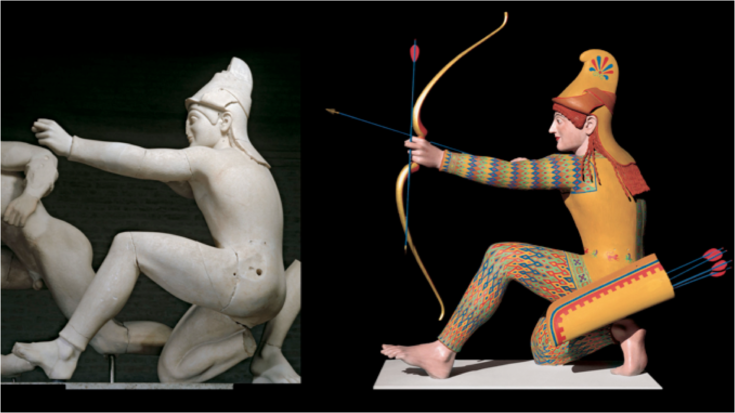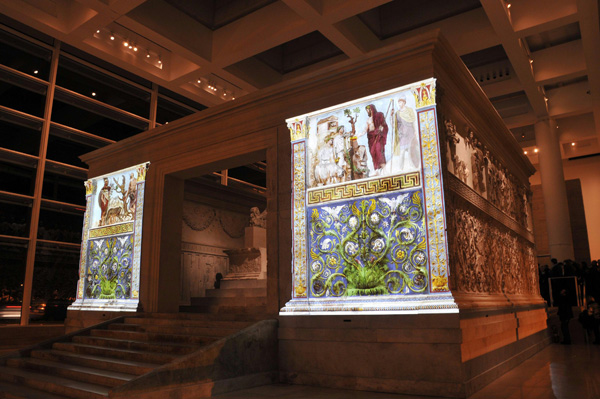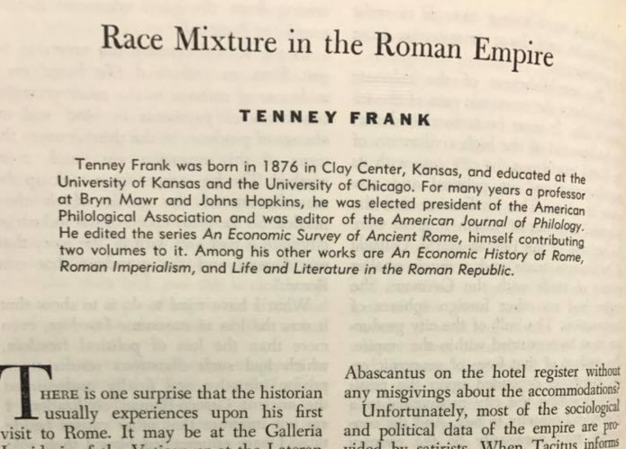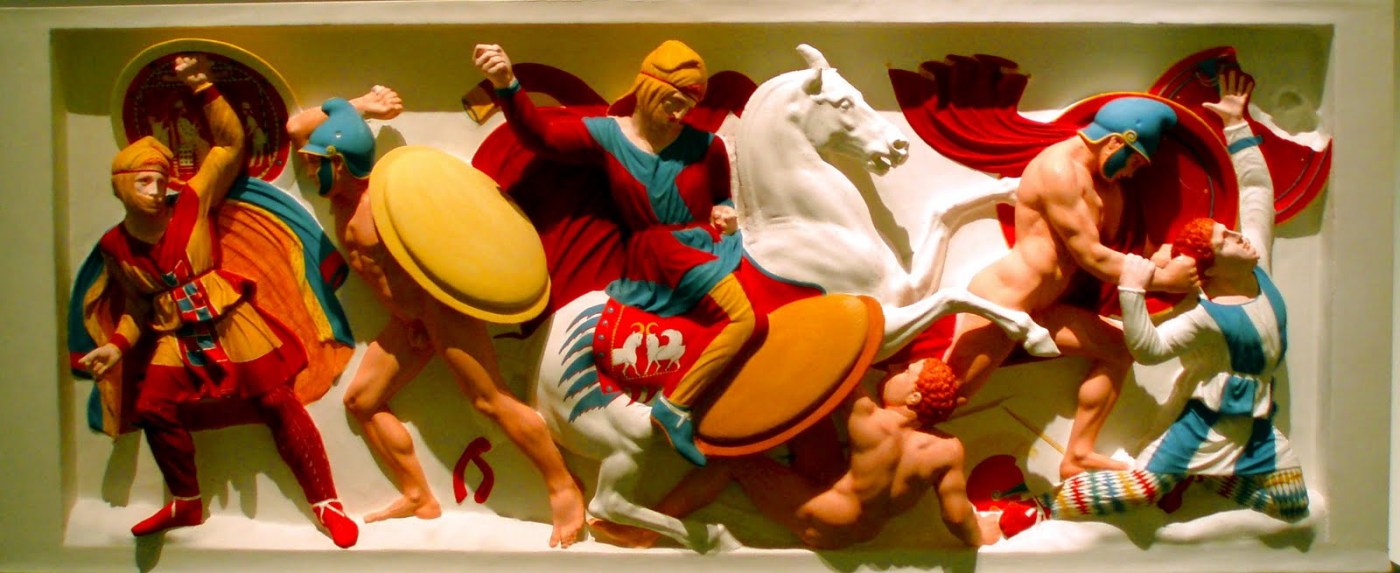It has been a few days since I published a piece on my Forbes blog regarding the perception of whiteness and statues in antiquity. I knew when I started taking notes on the subject of polychromy many months ago that this column would likely cause a stir within the field, among colleagues, and online. I had thought that I was prepared for the internet trolls. After all, I have crossed many proverbial bridges on Twitter––where they usually lurk. However, the hatred and invective I received from this post was more than anything I have ever received to date. As a result, I wanted to write a post on my personal blog in order to:
1) to provide a context for my argument through a broader bibliography on the subject of polychromy 2) to encourage the incorporation of the subject of race and art history into course syllabi and to provide an open discussion of racism in the 19th and 20th centuries to our students 3) to use these materials to recognize and then address the severe lack of diversity in the field of Classics.
Re: 2008 polychromy show @GettyMuseum. Here is an example from Morgantina, Sicily 325 BCE (where I used to excavate) https://t.co/tId3c7MiVz pic.twitter.com/eT9HF5Ntvs
— Sarah Bond (@SarahEBond) March 6, 2017
My main thesis is that despite our knowledge of the prevalence of polychromy on ancient statuary, there is a predominantly neon white display of skin tone in respect to classical statues and sarcophagi. This assemblage of neon whiteness thus creates a false sense of homogeneity across the Mediterranean world. Moreover the idea that white marble is beauty is not an inherent truth of the universe; it was in part developed by influential art historians during the early modern period in Europe. This visual argument continues to be asserted and to shape what we in the West consider to be pulchritudinous.
As I pointed out in the column, a number of fantastic museum shows throughout Europe and the U.S. in recent years have addressed the issue of polychromy. Digital humanists and archaeologists played a large part in making these shows possible. Archaeologist Vinzenz Brinkmann in particular has applied technologies such as ultraviolet light in order to analyze the minute vestiges of paint on ancient statues and then recreate polychromy versions of them.
If you have a moment, check out the 2003 “Gods of Color” exhibit that travelled the world after its initial display both at the Glyptothek in Munich and the Ny Carlsberg Glyptotek in Copenhagen. Many of the photos in this post come from that exhibit––including the famed Caligula bust (Forbes column) and the Alexander Sarcophagus (above). One of my favorites is the archer from the Temple of Aphaia in Aigina (490-480 BCE). Also make sure to check out the open content and images on the Getty Portal from a show called “The Color of Life“, which was on display at the Getty Villa in 2008.

Now that we have some background, the next question is: How can we address the problem of the lily white antiquity that exists in the public imagination? To be clear, I am not suggesting that we go back with a bucket in hand and repaint every marble statue across the country. However, I believe that better museum signage, the presentation of side-by-side 3D reconstructions, and the use of light (e.g. projections similar to the ones used on the Ara Pacis) can supplement and produce a contextual frame for understanding pieces. What a number of commenters have pointed out is that even when these statues are given color, they remain “white” and that, regardless of their color in antiquity, the restored color is simply too gauche. First, what do you even mean by “white”? I do not have the time to get into the cultural construction of whiteness and how it has changed to include Greeks and Italians in the 20th century, but please refer to historian Nell Irvin Painter‘s work on the subject and particularly to her piece in the New York Times, “What Is Whiteness?” White is not a category of analysis or identity used by those in antiquity.

In doing the research for this piece and then reading Painter’s book on the subject of whiteness, I had to confront the incredible amount of racism that has shaped the ideas of scholars we continue to cite today in the field of ancient history. Art historian Johann Joachim Winckelmann (d. 1768) is just one example. A more current racist that is often cited by Roman economic historians is Tenney Frank. Recently, I came across Frank’s disturbing article, “Race Mixture in the Roman Empire” (The American Historical Review, 21.4 [Jul., 1916]: 689-708) while looking through an edited volume. The article was then reprinted without comment in Greek historian Donald Kagan’s collection of articles on the “fall of Rome” (published in 1962) called Decline and Fall of the Roman Empire: Why Did It Collapse? I am not suggesting that Prof. Kagan is or is not a racist, but I am arguing here that the essay deserved to be contextualized in his introduction to the volume and highlighted as an example of the virulent racism in Classics in the 19th and early 20th centuries. As Denise Eileen McCoskey points out in her excellent book, Race: Antiquity and Its Legacy, Frank’s attempt to count inscriptions in order to gauge whether “race mixing” contributed to the decline of Rome is not only untrue, it is dangerous. It also provides ammunition for white supremacists today. I am not telling you to avoid citing Frank altogether, but just like those museum placards, we must annotate, contextualize, and question the theories of these individuals closely before we use them.

The last thing I wish to argue for in this post is a moment of reflection that endures. When we ask ourselves, as classicists, why we are such a non-diverse field we must consider whether we make it easy for people of color to want to study the ancient world. Do they see themselves in the ancient landscape that we present to them? Because they should. Moreover, discussing the shifting idea of what whiteness is remains important. Notably, I am a pretty white-looking lady, though I became less so in the eyes of internet trolls who this week found a blog post I wrote earlier in my life, wherein I discussed the fact that my maternal grandmother was indeed Jewish. Thanks for the parentheses treatment, guys, but I am quite okay with my heritage.
The dearth of people of color in media depicting the ancient world is a pivotal issue. Until I played Ryse: Son of Rome with my friend and colleague Hannah Scates Kettler, I didn’t realize how extreme this was. Hannah is a digital librarian and an ancient art historian, but she is also a woman of color. As she remarked to me, she does not see herself when watching movies or playing video games set in antiquity. I am not suggesting that we can change this fact over night, but I am telling you that 70% of my students tell me that these very video games and the watching of movies like Gladiator (which has a man from New Zealand playing the Spaniard Maximus) and the 300 (which has xenophobic depictions of Persians and predominantly northern European people playing Spartans) led them to take my course. If we want to see more diversity in Classics, we have to work harder as public historians to change the narrative, to talk to filmmakers, to write pop articles, and to do more outreach that emphasizes the vast palette of skin tones in the ancient Mediterranean. We do have the power to return the technicolor to the ancient world, but it does start with us.


I really wish more museums would (and had the resources to) put colored images next to the works. It would be so cool. I have some issues with Paimter’s book, though. Because I work on these issues myself, I found some of the errors in her antiquity sections difficult to swallow and ended up skipping those chapters entirely. And, while I appreciated other parts of the book, the narrowness of the scope of her 19th century material was challenging for me to get past. But, there is a new book coming out hopefully by the end of the year on classics and early anthropology that will broaden the scope and engage other ways in which government and university scientists used the classical past as support and justification for scientific racism. My own chapter for that volume is on the first director of ethnology at the Smithsonian. Iwhat you point to is also another reason why it is important for those of us who teach ethnicity in antiquity (and gender and sexuality) to include reception, particularly in the 19th/20th centuries as part of these courses. Otherwise, we give only half of the picture.
Once I learned that buildings in antiquity had been painted, suddenly I saw white as a kind of effacement— statues and reliefs seemed incomplete. If color can guide us into a more inclusive narrative about the ancient world, what an opportunity! Thank you Professor Bond for reinvigorating the past in lifelike hues.